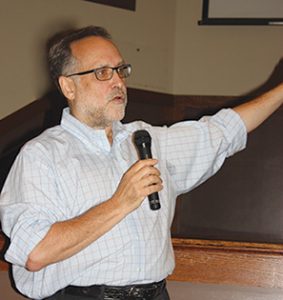Most Democratic presidential candidates support the concept, but they haven’t come together on a plan to pay for it
By MARY ANN HOLLEY
Correspondent

Dr. Ed Weisbart, a family medicine physician and chairman of the Missouri chapter of Physicians for a National Health Program, said when he graduated from medical school in 1973, and Richard Nixon created (HMOs), managed care medicine, he wanted to throw medicine behind him.
“But then, little by little things started to change,” Weisbart told guests at the recent “Medicare for All,” informational event sponsored by the St. Louis Labor Council’s Retirees Club.
Weisbart explained how the doctors were happy with what they were being paid, but each group of physicians had a budget. The sicker the patients, the more they had to spend of their budget. If a patient needed treatment for a condition that costs $1 million to treat, that one patient cost more than the office budget, Weisbart said.
The response? “We should make him decide he doesn’t want to see us, and we’d save $1 million a year. And that’s not only history. That is today,” Weisbart said.
Insurance companies want your premium and they want healthy people,” he said. “That’s a big reason we need Medicare for All. We need quality healthcare for all through a program that is fair to both patients and physicians.”
WHAT IS IT, REALLY?
Medicare, which has been around since 1965, is the government-run health insurance program that covers all Americans 65 and older and is funded by taxpayers. A portion taken out of our paychecks for Social Security goes toward Medicare to cover most services like hospital stays and doctor visits.

People on Medicare can also choose to get additional coverage from Medicare-approved private insurers to cover other services such as dental, vision and prescription drugs.
Proponents of Medicare for All want to expand this program to cover more than just Americans 65 and older.
Most leading candidates for the Democratic presidential nomination have endorsed the concept of Medicare for All, but they haven’t come together on a plan to pay for it, Weisbart said.
In the last congressional session, there were at least eight other proposals introduced in the House and the Senate aiming to expand the program. Some would have expanded the program by lowering the Medicare age eligibility to 50; other bills added a Medicare option while maintaining private insurance choices.
But Medicare for All is leading the way with voters. A CNN poll from July 1 found that 56 percent of Americans support a national health insurance program for all Americans, even if it would require higher taxes. An earlier Kaiser Family Foundation survey from January found that 56 percent of Americans support Medicare for All.
Last summer, Democratic Rep. Pramila Jayapal of Washington helped found the Medicare for All Caucus, which now has 78 Democratic representatives as members.
The majority of the unions have also endorsed House Bill 1384 proposing “Medicare for All.”
BE AN INFORMED VOTER
Weisbart urges voters to understand the differences in the various candidates’ proposals to be better informed when they cast their ballots.
Medicare is an efficient healthcare financing system, Weisbart said. Medicare for All would cover all Americans of all ages, eliminate all copays and deductibles, allow free choice of doctors and hospitals and improve benefits so all Americans would have access to dentistry, optometry, hearing aids and more.
In a broad sense, Medicare for All calls for restructuring the current patchwork of private insurance that is both inefficient and expensive. At present, the United States is the only industrialized nation in the world without some form of universal healthcare.
LOWER HEALTHCARE COSTS
Under Medicare for All, the redirection of premium dollars now paid by individuals and employers to private insurance companies, Weisbart explains, would bring down healthcare costs by as much as one-third, thus freeing up funds needed to add essential services such as dentistry, optometry and hearing aids, while eliminating all copays and deductibles.
“The key to how do you pay for it is that 29 studies say the country would break even or come out ahead,” Weisbart said. “When more people have access to medical care, they are generally healthier because of the preventative medicine and other services available to them –– saving money in the long run.”


